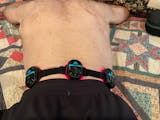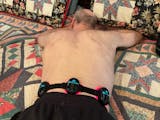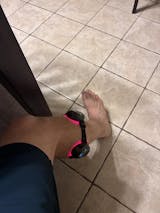What Is Tendinitis

Tendinitis, commonly known as tendonitis, is a condition that affects the tendons, causing pain, inflammation, and restricted movement. It can occur in any part of the body where tendons are found, but it is most common in the shoulders, elbows, knees, and wrists. This condition often arises due to overuse, injury, or repetitive motions. Many people turn to treatments like medical-grade red light therapy devices to help relieve symptoms and promote faster recovery.
What Is Tendinitis
Definition and Overview
Tendinitis refers to the inflammation or irritation of a tendon, often caused by repetitive movement or overuse. It can cause pain, swelling, and limited range of motion in the affected area. Understanding the basic nature of tendinitis is crucial for identifying and treating it effectively.
Causes of Tendinitis
The primary cause of tendinitis is repetitive motion, especially in sports, work environments, or daily tasks that involve repetitive hand, wrist, or shoulder movements. Other contributing factors include aging, poor posture, and improper technique during physical activity.

Symptoms of Tendinitis
Symptoms can vary based on the severity and location of tendinitis, but they generally include localized pain, swelling, tenderness, and difficulty moving the affected joint. In some cases, warmth around the area and a feeling of weakness may also occur.
Common Types of Tendinitis
Tennis Elbow (Lateral Epicondylitis)
This is one of the most common forms of tendinitis, affecting the tendons on the outside of the elbow. It's typically caused by repetitive motion, such as that experienced by tennis players or individuals who engage in similar repetitive activities.
Golfer’s Elbow (Medial Epicondylitis)
This type of tendinitis affects the tendons on the inside of the elbow and is caused by repetitive gripping or throwing motions. It’s commonly seen in golfers, but also in people who work with tools or in manual labor.
Rotator Cuff Tendinitis
Rotator cuff tendinitis occurs in the shoulder, often affecting individuals who perform overhead activities or repetitive arm movements. This condition can result in difficulty lifting the arm or pain during specific movements.
Patellar Tendinitis (Jumper's Knee)
Patellar tendinitis affects the knee, specifically the tendon connecting the kneecap to the shin bone. It is commonly seen in athletes, particularly those who participate in jumping or running sports.

Risk Factors for Developing Tendinitis
Age and Degeneration
As people age, tendons lose elasticity and become more prone to injury and inflammation. Older adults are more likely to develop tendinitis due to the natural wear and tear on their tendons.
Overuse and Repetitive Movements
Repetitive motions, especially those performed in a work or sports setting, are a major risk factor. This includes activities like typing, playing tennis, or lifting heavy objects frequently.
Poor Technique and Posture
Improper form or posture during physical activities or repetitive tasks can increase the strain on tendons and lead to tendinitis. It's crucial to use correct body mechanics to prevent unnecessary stress on the tendons.
How to Diagnose Tendinitis
Physical Examination
Doctors will often perform a physical examination to assess tenderness, swelling, and range of motion in the affected area. They may ask about the patient’s medical history and any recent activities that could have led to the injury.
Imaging Tests
In some cases, imaging tests such as X-rays, MRI scans, or ultrasound may be used to confirm the diagnosis. These tests help rule out other possible conditions and allow the doctor to assess the extent of tendon damage.

Treatment Options for Tendinitis
Rest and Ice Therapy
Resting the affected area and applying ice can help reduce inflammation and prevent further strain on the tendon. Ice therapy is most effective during the first 48 hours after experiencing symptoms.
Physical Therapy and Stretching
Physical therapy is an effective way to rehabilitate the tendon and restore flexibility. Stretching exercises and strengthening routines can help improve the condition and reduce the likelihood of future injuries.
Anti-inflammatory Medications
Over-the-counter anti-inflammatory medications, like ibuprofen, are commonly used to reduce pain and swelling. In more severe cases, a doctor may prescribe stronger medications or corticosteroid injections.
Medical-Grade Red Light Therapy Devices
For those seeking a more advanced approach, medical-grade red light therapy devices - PRUNGO FluxGo are an excellent option. These devices utilize low-level laser therapy (LLLT) to promote healing, reduce inflammation, and relieve pain in the affected area. FDA approved red light therapy can accelerate the recovery process by improving circulation and stimulating tissue repair.
The Role of Red Light Therapy in Treating Tendinitis
How Red Light Therapy Works
Red light therapy at home works by delivering light at specific wavelengths to penetrate deep into tissues. This light energy stimulates the mitochondria in cells, promoting healing and reducing inflammation in tendons and surrounding tissues.
Benefits of Red Light Therapy for Tendinitis
The benefits of red light therapy for tendinitis include pain relief, faster healing time, and improved mobility. It also helps reduce the need for more invasive treatments like surgery or steroid injections.
Clinical Studies and Effectiveness
Numerous clinical studies have demonstrated the positive effects of red light therapy for treating tendinitis. It has been shown to significantly reduce pain and inflammation while promoting tissue repair, making it an increasingly popular option for many people with tendinitis.

Preventing Tendinitis: Tips for a Healthy Lifestyle
Warm-Up and Cool Down Properly
Before engaging in any physical activity, it’s important to properly warm up your muscles and tendons to reduce the risk of injury. Cooling down afterward also helps to relax muscles and prevent strain.
Strengthen and Stretch Regularly
Regular stretching and strengthening exercises can improve tendon flexibility and resilience. Incorporating these exercises into your routine can help prevent tendinitis and other tendon-related injuries.
Use Proper Equipment and Technique
Using the right tools and maintaining proper posture while performing tasks or playing sports can greatly reduce the strain on your tendons. Wearing supportive shoes and using ergonomic tools can help reduce the risk of developing tendinitis.
Conclusion
Tendinitis is a common and treatable condition, but it can significantly impact your daily life. Understanding its causes, symptoms, and treatment options is crucial for effective management. From rest and physical therapy to advanced treatments like medical-grade red light therapy, there are several methods available to relieve pain and accelerate recovery.
For treatment, red light therapy panels are ideal for large-area applications, providing effective pain relief and recovery. If your goal is facial care, a red light therapy mask is even more ideal, covering multiple facial areas and particularly suitable for anti-aging, soothing skin, and repairing damaged tissue. Red light masks also help improve skin health, reduce fine lines, even out skin tone, and effectively alleviate acne and other problems.




















0 comments